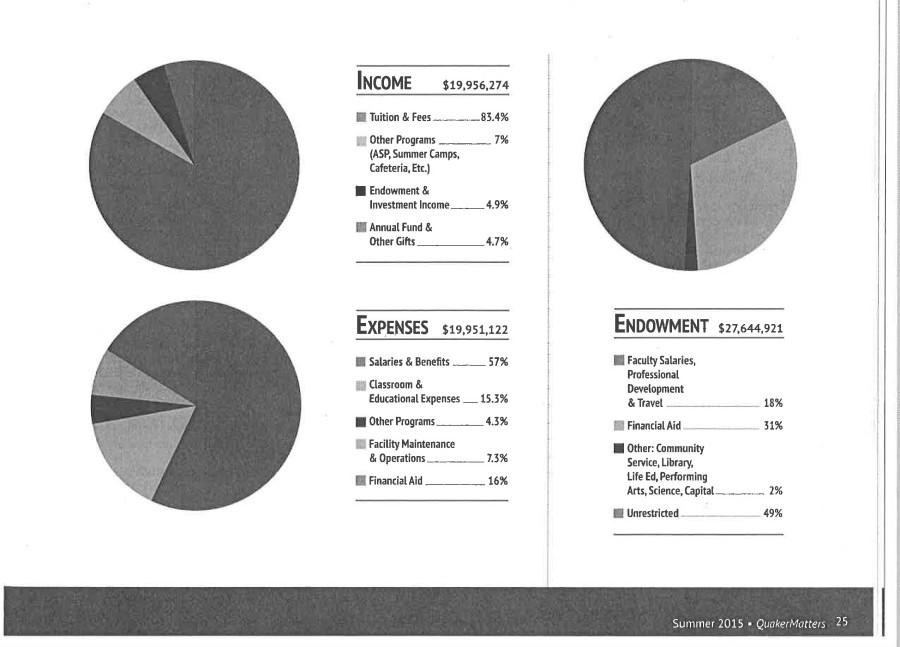Budget At Friends Reaches Nearly $20,000,000
Holiday 2015: Innovation and the Mind
The budget for the WFS 2014-2015 school year.
The budget for the 2014-2015 school year was $19,956,274. The majority of this income, 83.4%, came from tuition and fees; another 7% from other programs such as ASP, summer camps, and the cafeteria; 57% was spent on the salaries and benefits for the faculty and staff; 15.3% was spent on classroom and educational expenses; finally, 7.3% was spent on facility maintenance and operations. How is a budget worth nearly $20 million created?
Every year in January, the Wilmington Friends Finance Committee meets to set a preliminary budget for the coming year. This budget is revisited in September of the following year, where it is then finalized and implemented. The creation of this budget starts within each department. Each department completes a budget sheet that accounts for all programs that the department sponsors. After the division head reviews all sheets, they are sent to the Head of Finance and Operations, Bill Baczkowski.
Sometimes programs are added to the budget based on competitive appeal or connection to the school curriculum, such as the robotics program. But in order to add, expenditures must be cut. If programs are losing enrollment; for example, currently the lower school, the funds may be reallocated to where they are needed more.
Exactly thirty years ago, the budget of Wilmington Friends School was published on the front page of the Whittier. The budget for the 1984-1985 school year was $3,407,631. As is the case for last year’s budget, the majority of the income came from tuition and fees, exactly 87.42%. In a common trend, the largest expenditure in the budget money went towards faculty and staff salaries and benefits, exactly 71.8%.
Baczkowski explained that the budget is so much larger today than it was thirty years ago because of inflation and market competition, “[The budget increase] all starts with the need for all human beings to attain a higher standard of living. In order to be the best school we can be, we must recruit the best faculty, staff and administration that we can get and in doing so we face market competition for their services. We must pay market rates to get the best and therefore we have to increase tuition to cover the cost of not only our personnel, but our other resources like classroom supplies and electricity that have also increased from a desire for those companies to pay for their resources.
Indeed much has changed since 1985 as technology has taken off.”These priorities are the reason that close to 57% of the budget is comprised of faculty and staff salaries and benefits. In addition to this primary allocation, a new priority since 1985 is financial aid. Currently, financial aid makes up 16% of the budget, an increase since 1985, when financial aid comprised only 7% of the budget. This change in allocation, Baczkowski reasons, is due to the financial downturn of 2008.
Much has changed since 1985, including the recent additions to the Friends campus, such as the Global Learning Center and the Library Learning Commons. But unlike the funding of programs or salaries, projects like the GLC are created through the funds from a capital project, not from the budget.
Once these projects are created, the budget then absorbs their costs. In the case of the Global Learning Center, due to its lack of carbon footprint from the solar panels on the roof and the geothermal wells, the relative costs to run the building are fairly small. From a budgetary standpoint, its costs can be absorbed. On the other hand, after a capital campaign funded the new theater, more money in the budget had to be allocated to its cost and maintenance. The goal in the creation of new facilities is to draw more students, and thus more income to pay for the new expenses. The recent additions seem to be having this effect, as enrollment this year has increased since last year with 286 students in the upper school, and 736 students overall across divisions.
Intellectual development has recently become the forefront of budgetary goals. Baczkowski says that this commitment manifests itself in the new One-to-One program with the Apple laptops. In order to tap into this innovation, Friends offers Curriculum Innovation Grants that are available to the faculty. To qualify for one such grant, faculty must submit a proposal to the administration, and if granted, their work would take place over the summer when there is more time to do so. Faculty can also take advantage of Master Teacher Grants, a program where teachers are given a certain amount of money to study something that would enhance the classroom experience, as well as their professional development budget to “seek and learn more about innovation in their discipline.” Faculty engagement, Baczkowski argues, “that’s where real innovation comes from.”




































